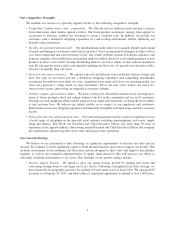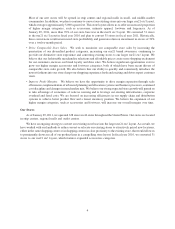Rue 21 2010 Annual Report Download - page 19
Download and view the complete annual report
Please find page 19 of the 2010 Rue 21 annual report below. You can navigate through the pages in the report by either clicking on the pages listed below, or by using the keyword search tool below to find specific information within the annual report.and at the costs estimated by us could have a material adverse effect on our business and result in a decline in the
price of our common stock.
Our growth strategy will require us to expand and improve our operations and could strain our existing
resources and cause the performance of our existing stores to suffer.
Our operating complexity will increase as our store base grows. Such increased complexity will require that we
continue to expand and improve our operating capabilities, and grow, train and manage our employee base. We will
need to continually evaluate the adequacy of our information and distribution systems and controls and procedures
related to financial reporting. Implementing new systems, controls and procedures and any changes to existing
systems, controls and procedures could present challenges we do not anticipate and could negatively impact us.
In addition, we may be unable to hire, train and retain a sufficient number of personnel or successfully manage
our growth; moreover, our planned expansion will place increased demands on our existing operational, managerial,
administrative and other resources. These increased demands could cause us to operate our business less effectively,
which in turn could cause deterioration in the financial performance of our individual stores or our overall business.
Our rapid growth also makes it difficult for us to adequately predict the expenditures we will need to make in
the future. This growth may also place increased burdens on our vendors, as we will likely increase the size of our
merchandise orders in connection with such growth. In addition, increased orders may negatively impact our
approach of generally striving to minimize the time from purchase order to product delivery, and may increase our
markdown risk. If we do not make the necessary capital or other expenditures necessary to accommodate our future
growth, we may not be successful in our growth strategy. We may be unable to anticipate all of the demands that our
expanding operations will impose on our business, personnel, systems and controls and procedures, and our failure
to appropriately address such demands could have a material adverse effect on us.
Our business depends in part on a strong brand image, and if we are not able to maintain and enhance
our brand, particularly in new markets where we have limited brand recognition, we may be unable to
attract a sufficient number of customers to our stores or sell sufficient quantities of our products.
We believe that the brand image we have developed has contributed significantly to the success of our business.
We also believe that maintaining and enhancing our brand image, particularly in new markets where we have
limited brand recognition, is important to maintaining and expanding our customer base. Maintaining and
enhancing our brand image may require us to make substantial investments in areas such as merchandising,
marketing, store operations, community relations, store promotions and employee training, and these investments
may not be successful. Moreover, we do not utilize some of the advertising and marketing media used by some of
our competitors, including advertising through the use of newspapers, magazines, billboards, television and radio.
We believe our customers are influenced by word-of-mouth and social media marketing when deciding where to
shop. As a result, we employ a viral approach to marketing that is designed to capture the interest of our customers
and drive them into our stores. For example, we offer promotions and contests through our website, we provide
product knowledge, trend statements and fashion blogs through Facebook, Twitter and YouTube and we send
regular “e-blasts” to customers to highlight key trends, new products and promotional events.
Because we do not rely on traditional advertising channels, such as newspaper or television advertisements, if
our viral marketing efforts are not successful, there may be no immediately available alternative marketing channel
for us to build awareness of our products in a manner that we think will be successful. This may impair our ability to
successfully integrate new stores into the surrounding communities, to expand into new markets or to maintain the
strength or distinctiveness of our brand image in our existing markets. In addition, if our viral marketing efforts are
unsuccessful or we are otherwise required to use traditional advertising channels in our overall marketing strategy,
then we will incur additional expenses associated with the transition to and operation of traditional advertising
channels. Failure to successfully market our products and brand in new and existing markets could harm our
business, results of operations and financial condition.
As of January 29, 2011, our 638 stores are located in 609 cities in 44 states. A primary component of our
strategy involves expanding into new geographic markets. As we expand into new geographic markets, we may be
unable to develop, and consumers in these markets may not accept, our brand without significant additional
15
























